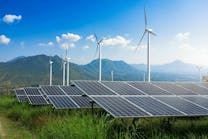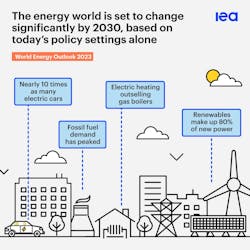In May 2021, the International Energy Agency (IEA) published its Net Zero by 2050, A Roadmap for the Global Energy Sector. Not surprisingly, it began with bad news, pointing out that, although the number of countries pledging net zero emissions kept rising, even with 100% compliance the goal would not be met.
Between 1992, when the UN Framework Convention on Climate Change was signed, and the release of the Roadmap in 2021, worldwide CO2 emissions increased by 60%. Since then, most of the news regarding the 1.5° C. global warming limit and the goal of net zero global energy-related CO2 emissions has been disheartening, at best, or downright alarming, at worst.
Now, however, the IEA has given us a glimmer of hope with its newly updated 2023 Roadmap.
The original document was literally a roadmap, of sorts, establishing more than 400 milestones to be reached on the road to decarbonization. One such milestone then was the daily installation of solar PV systems equivalent in size to the world’s then-largest solar farm.
Although, I had thought that sounded aspirational at the time, according to the new report
Positive developments over the past two years include solar PV installations and electric car sales tracking in line with the milestones set out for them in our 2021 Net Zero by 2050 report. In response to the pandemic and the global energy crisis triggered by Russia’s invasion of Ukraine, governments around the world announced a raft of measures designed to promote the uptake of a range of clean energy technologies. Industry is ramping up quickly to supply many of them. If fully implemented, currently announced manufacturing capacity expansions for solar PV and batteries would be sufficient to meet demand by 2030 in this update of the NZE scenario.
That's definitely good news. Meanwhile, the new report also points out that the case for climate action is stronger than ever. Many of us just suffered through the hottest summer on record and other severe weather events, linked to climate change, continue to increase.
- Download our new eBook, celebrating 10 Years of Clark's Remarks. Click here.
The political case is also strong. In December, the next UN Climate Conference (COP28) will convene in Dubai, and it will see the conclusion of the first global stocktake (GST). According to Nature Climate Change, the GST “assesses efforts towards long-term climate targets. In addition to the assessment process, the stocktake could also address current problems within climate governance and interact with other policy instruments.”
The GST process is “designed to evaluate the collective progress every five years towards the mitigation, adaptation and finance goals set out in the Paris Agreement. Based on the outputs of the GST process, each party is expected to update their nationally determined contribution (NDC) with increased ambitions.”
Although generally optimistic, the new Roadmap does still note that countries will have to spend more in order to transition from fossil fuels to cleaner forms of energy. Currently on track this year to spend $1.8 trillion on clean energy, that amount will have to increase to $4.5 trillion in the next 10 years or so, in order to meet the goals. According to IEA, increasing renewable energy installations by 300% will have the most significant effect on global emissions reductions.
Finally, the new report suggests that, although no new major oil and gas projects, coal mines, or coal plants are needed, “continued investment is required in existing oil and gas assets and already approved projects” in order to avoid what it refers to as “damaging price spikes or supply gluts.”
Yes, an optimistic climate report, with a dash of common sense mixed in, is a refreshing change.
##########
A contributor to HPAC Engineering since 2013 and a member of its editorial advisory board, the author is a principal at Sustainable Performance Solutions LLC, a south Florida-based engineering firm focusing on energy and sustainability. He can be reached at [email protected].










